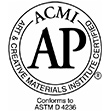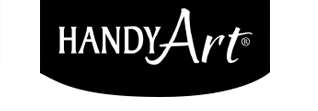Products
Information

Health & Safety
Knowledge of materials and their proper use helps to make them safe. Handy Art® believes strongly in providing the user with all the information they need to safely enjoy their art experience. To this end, with the exception of our Face Paint which conforms to ASTM D 4236, all Handy Art® products are certified AP non-toxic. However, it is always best to treat all materials with respect and handle them properly.
Always attempt to minimize skin contact with paint products. Do not use products for skin painting that are not specifically formulated and labeled for such use. Wash up after use, both yourself and your supplies. Do not eat, drink or smoke while using art materials and be sure to wash your hands before you do any of these activities. Following these simple guidelines will allow you to have a safe, fun and enjoyable experience.
Handy Art®, Little Masters®, Nu Master® and Designer's Palette® products do not contain the following common allergens:
• Does not contain Latex
• Does not contain Dairy or Casein
• Does not contain Soy*
• Does not contain Egg
• Does not contain Gluten
• Does not contain Peanut or Tree Nuts
*Handy Art® Face Paint does contain Soy Lecithin
Paint Care Tips
• Always store paint in a cool, dry place. Extreme temperatures, such as freezing or above 90 degrees F, can cause pigment settling and viscosity changes that may make the paint unusable.
• Opened paint containers should be used within 6 months. Unopened paint containers may be stored for up to 2 years. If opened at the end of the shelf life (2 years), the paint should be used as quickly as possible.
• To prevent cross contamination of the paint, which may cause it to degrade and spoil, follow these steps:
• Pour amount of paint to be used into smaller, resealable containers. And be sure
to use fresh water to clean your brushes when working out of the smaller
containers.
• Do not pour used paint back into the original container.
• Do not dilute product in the original container.
• Do not dip brushes or other applicators into the original container.
• Clean pumps when moving them from one container to another.
• Do not mix different paints in the original container.
• By following these steps, if contamination occurs, only a small amount of paint will be lost, not the entire container.
• Always be sure to close cap/lid tightly after each use and to permanently remove and dispose of any seal on the container or paper in the cap/lid.
What does the ACMI Seal mean?
 The new AP (Approved Product) Seal, with or without Performance Certification, identifies art materials that are safe and that are certified in a toxicological evaluation by a medical expert to contain no materials in sufficient quantities to be toxic or injurious to humans, including children, or to cause acute or chronic health problems. This seal is currently replacing the previous non-toxic seals: CP (Certified Product), AP (Approved Product), and HL Health Label (Non-Toxic) over a 10-year phase-in period. Such products are certified by ACMI to be labeled in accordance with the chronic hazard labeling standard, ASTM D 4236, and the U. S. Labeling of Hazardous Art Materials Act (LHAMA). Additionally, products bearing the AP Seal with Performance Certification or the CP Seal are certified to meet specific requirements of material, workmanship, working qualities, and color developed by ACMI and others through recognized standards organizations, such as the American National Standards Institute (ANSI) and the American Society for Testing and Materials (ASTM). Some products cannot attain this performance certification because no quality standard currently exists for certain types of products.
The new AP (Approved Product) Seal, with or without Performance Certification, identifies art materials that are safe and that are certified in a toxicological evaluation by a medical expert to contain no materials in sufficient quantities to be toxic or injurious to humans, including children, or to cause acute or chronic health problems. This seal is currently replacing the previous non-toxic seals: CP (Certified Product), AP (Approved Product), and HL Health Label (Non-Toxic) over a 10-year phase-in period. Such products are certified by ACMI to be labeled in accordance with the chronic hazard labeling standard, ASTM D 4236, and the U. S. Labeling of Hazardous Art Materials Act (LHAMA). Additionally, products bearing the AP Seal with Performance Certification or the CP Seal are certified to meet specific requirements of material, workmanship, working qualities, and color developed by ACMI and others through recognized standards organizations, such as the American National Standards Institute (ANSI) and the American Society for Testing and Materials (ASTM). Some products cannot attain this performance certification because no quality standard currently exists for certain types of products.
|
Acrylic
Washable
Designer's Palette® Artists' Acrylic
|
Tempera
Nu Master®
Little Masters®
Block Printing Ink
Marbling Concentrate
Fabric Paint
India Ink
|
All Handy Art products are proudly made in the U.S.A.


